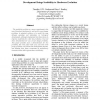Free Online Productivity Tools
i2Speak
i2Symbol
i2OCR
iTex2Img
iWeb2Print
iWeb2Shot
i2Type
iPdf2Split
iPdf2Merge
i2Bopomofo
i2Arabic
i2Style
i2Image
i2PDF
iLatex2Rtf
Sci2ools
EH
2005
IEEE
2005
IEEE
Development Brings Scalability to Hardware Evolution
The scalability problem is a major impediment to the use of hardware evolution for real-world circuit design problems. A potential solution is to model the map between genotype and phenotype on biological development. Although development has been shown to improve scalability for a few toy problems, it has not been demonstrated for any circuit design problems. This paper presents such a demonstration for two problems, the n-bit adder with carry and even n-bit parity problems, and shows that development imposes, and benefits from, fewer constraints on evolutionary innovation than other approaches to scalability.
| Added | 24 Jun 2010 |
| Updated | 24 Jun 2010 |
| Type | Conference |
| Year | 2005 |
| Where | EH |
| Authors | Timothy G. W. Gordon, Peter J. Bentley |
Comments (0)

